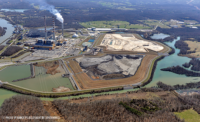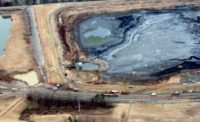The Tennessee Valley Authority will spend $216 million to determine feasibility of installing a cap with solar panels on a 300-acre closed coal-ash disposal impoundment at its Shawnee coal-fired plant near Paducah, Ky., terming the approach the "first of its type" in the U.S.
The federal power producer's board approved the project Nov. 10, which TVA will design, noting that if successful, it would be used at 20 other coal ash sites that could generate 1,000 MW of clean power.
The Shawnee project would produce 100 MW that could be connected to existing plant transmission, said TVA.
The solar panel system would be installed on a closed impoundment, atop a patented closure turf cap system at the impoundment that would protect its structural integrity, said Scott Brooks, a TVA spokesman.
The site has other still to be closed impoundments and nine active power units.
The current impoundment has a groundwater monitoring system to assess both upstream and downstream impacts. In 2021, it found that one mineral, molybdenum, had exceeded federal groundwater protection standards.
The solar project would require a federal environmental review and approval by Kentucky regulators, he said.
Environmentalists noted the TVA effort to add renewable energy but are concerned it will be a risky tradeoff for clean water in neighboring communities. The power producer is "willing to put solar on a coal ash impoundment but not to look at other TVA sites for solar projects,” Amy Kelly, Tennessee’s representative on the Sierra Club's "Beyond Coal" campaign, told ENR. “We want solar on brownfields, but we’re not sure we want it on coal ash sites.”
FirstEnergy Corp. also plans to build a solar plant on a closed coal ash landfill in West Virginia, but its toxic materials were already removed through a 20-year effort to use the byproducts in cement manufacturing. FirstEnergy harvested 3.1 million tons of ash that was sold to two major cement manufacturers to fuel cement kilns, the firm said in August.
A subsidiary, Mon Power, plans to build a 6-MW solar facility at the 26-acre site as part of a plan to construct five utility-scale solar facilities totaling 50 MW of renewable generation.





Post a comment to this article
Report Abusive Comment